1lumen selects and reviews products personally. We may earn affiliate commissions through our links, which help support our testing.
Convoy L7 review
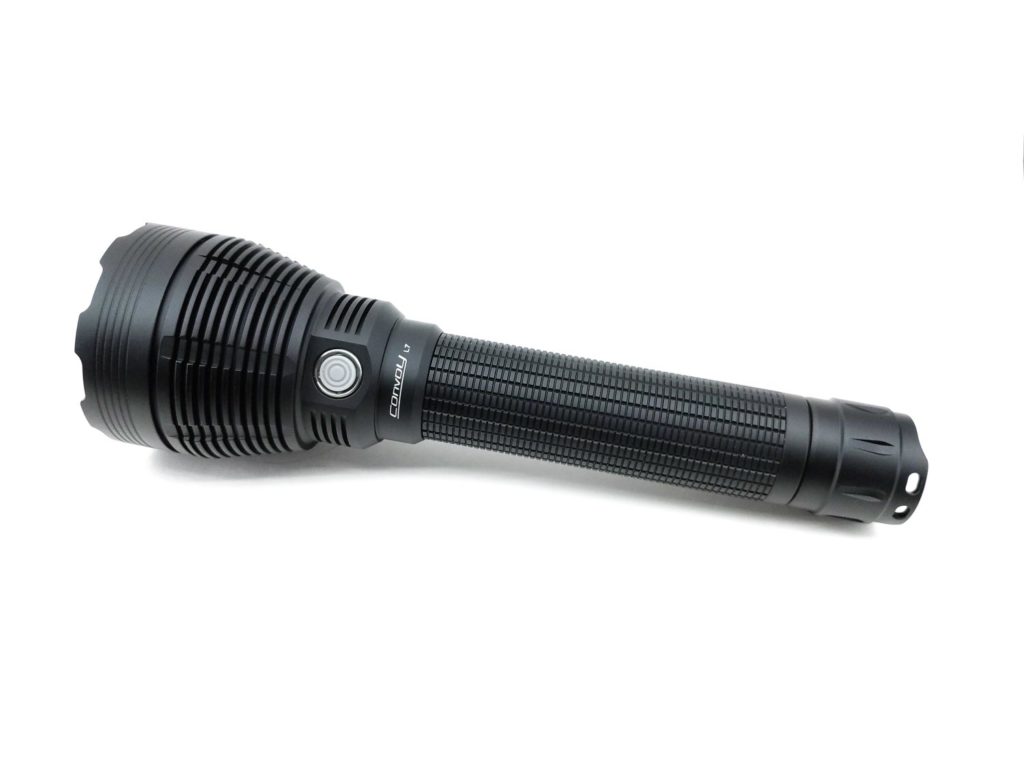
Convoy L7 specifications
| Brand/model | Convoy L7 |
|---|---|
| LED | Luminus SBT90.2 |
| Lumens | 5,900 lm |
| Beam intensity | 435,000 cd |
| Battery config. | 2*26650 |
| Material | Aluminum |
| Modes | 4 |
| Blinkies | Strobe |
| Reflector | Smooth |
| Waterproof | N/A |
| Review date | August 2021 |
Introduction:
Convoy is the brand that first brought me into the custom flashlight scene at BudgetLightForum. Convoy didn’t necessarily have the fanciest, craziest, or most tricked-out flashlights ever. Rather, Simon Mao (the man behind Convoy) had a reputation for listening to community feedback and for providing rock-solid flashlights whose value exceeded their asking price. It’s also one of the very few brands that actually sell “hosts” (a flashlight body without LED or driver). But that’s not to say that Convoy doesn’t produce amazing flashlights. On the contrary, I’ve come to expect great built quality even if I’m not getting cutting edge specs most of the time.
Convoy has been producing the L6 model for several years now: a powerful, large 2×26650 model with an XHP70 or XHP70.2 quad-die LED. While the XHP70.2 is a venerable LED, the Luminus SBT90.2 is all the rage these days. Simon decided that he wanted to incorporate one into the L6, but that it warranted more than a simple LED swap: it deserved an entirely new model. And thus, the Convoy L7 was born.
Package quality.
True to Convoy form, the L7 arrived in a very sturdy brown paper-board box lined with foam. No external branding or other markings, outside of a sticker stating the flashlight model and LED specs. Inside that box was:
- Convoy L7
- Cigar-grip ring
Yup, that’s it. No lanyard, no o-rings. Not even a manual! Simon wasn’t messing around. You bought a flashlight, and a flashlight is what you got! But every little nicety skipped is money saved, and that carries through to the selling price.

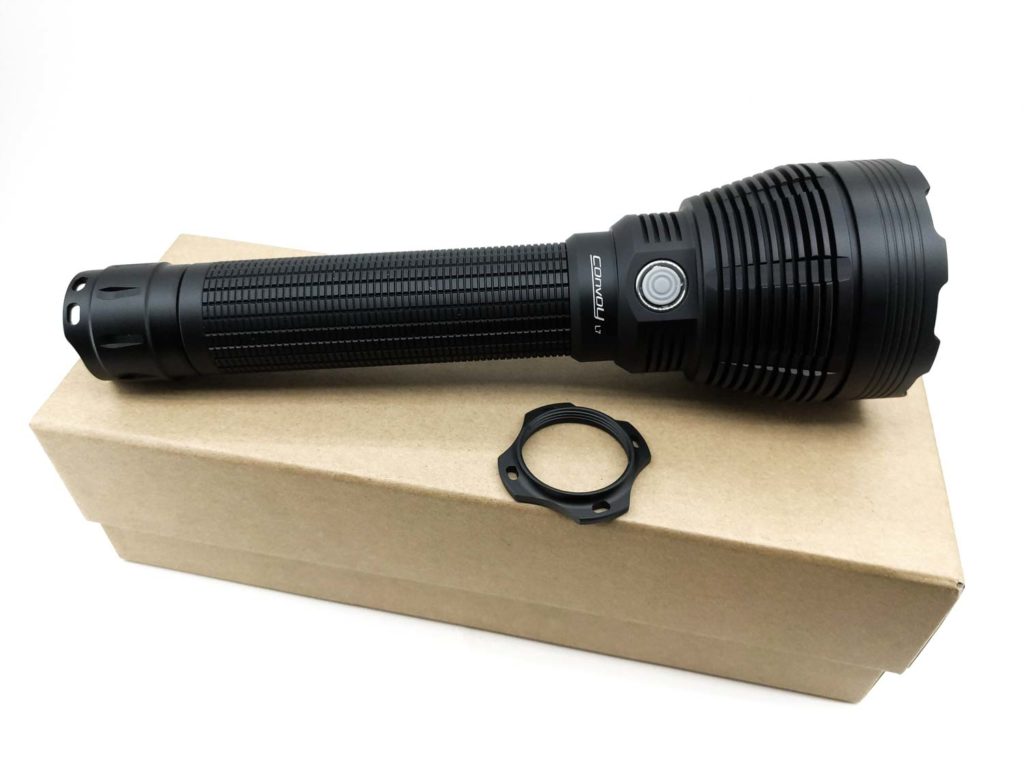
Flashlight in use
When I look at the Convoy L7 (or it’s predecessor, the L6), it seems huge. And perhaps, by today’s standards, it is. But growing up, it seemed like the most common flashlights were Maglite 2D and 3D. Back then, they didn’t strike me as being large. And you know what? The L6/L7 is the same length as the Maglite 2D. The body tube is thinner than the D-cell flashlight, albeit with a wider bezel.
The Convoy L7 uses a dual-switch setup. There’s an e-switch on the head for mode switching. And there’s a forward-clicky in the tail for on-off purposes. The tailcap has large holes for attaching a lanyard, though one was not included. When you remove the tailcap, you can also remove a small smooth ring that comes pre-installed and replace it with the included metal cigar-grip ring. That’s a nice add-on, plus it helps to provide a bit of roll protection. The L7 can tail-stand, but between the saddle-style tailcap and the flashlight being top-heavy, it’s not super stable.
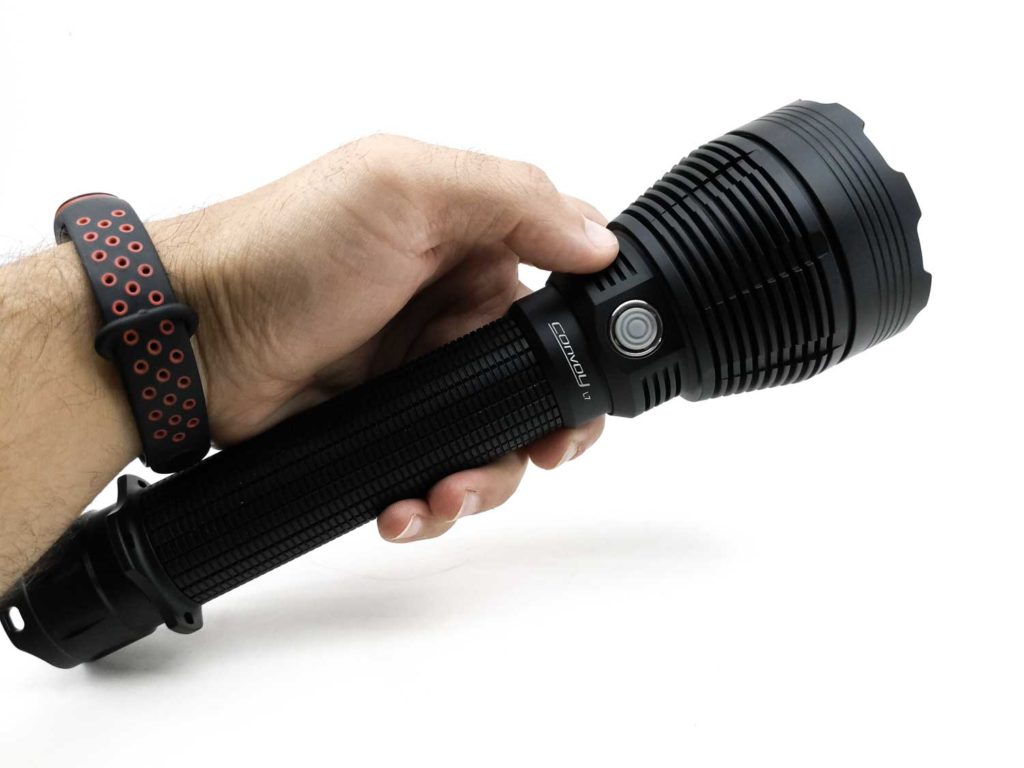
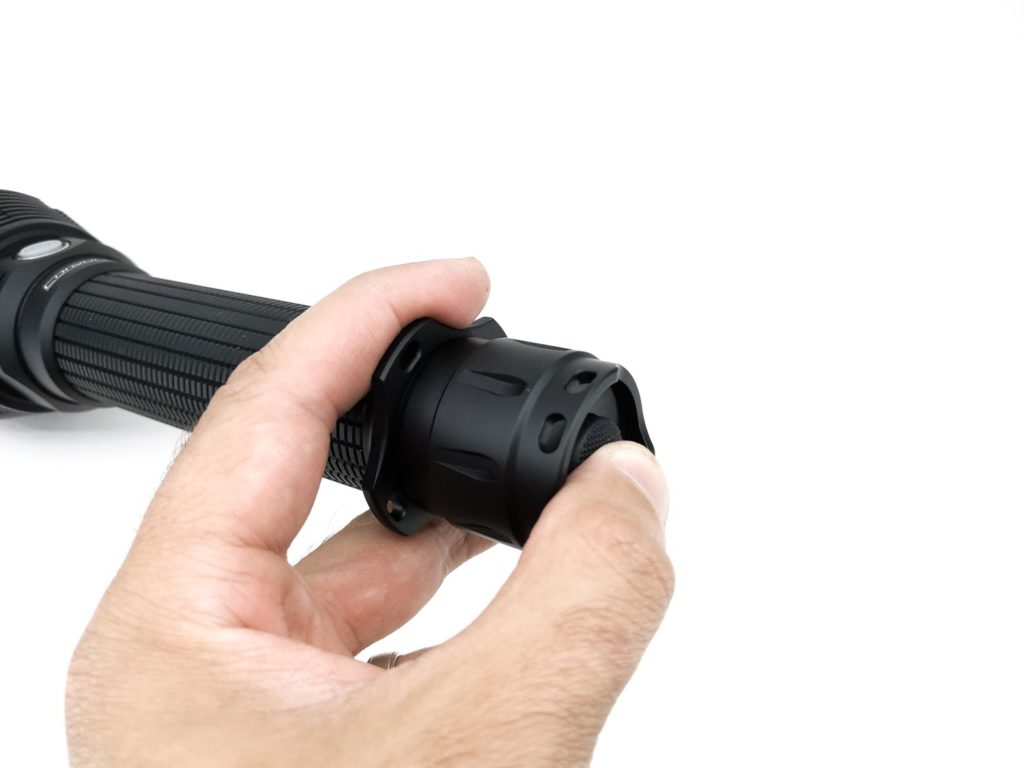
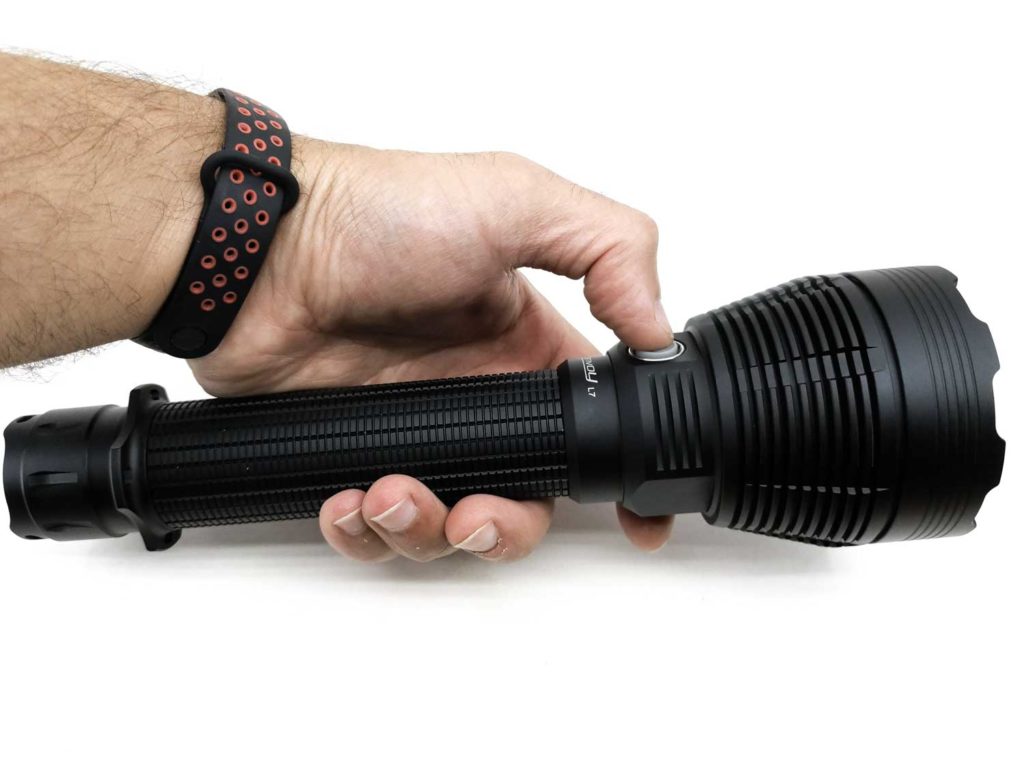
Build Quality, and Warranty
The body of the Convoy L7 is covered in matte black anodizing of an unspecified hardness level. The knurling has been updated since the L6, the body tube is now covered in a series of moderately small rectangles. To be honest, it kinda reminds me of an ear of corn (but then again, I work in agriculture and am always thinking about corn). The threads are smooth, square-cut, beefy, and pre-lubed. The front threads are non-anodized, and the rear threads are anodized. The single tailcap spring is a bit small and flexes easily under the weight of the batteries, perhaps a bit too easily (more on that later). The driver utilizes a copper (or brass) post instead of a spring. Overall, the L7 feels stout… like you could club an attacking bear after you’ve blinded him with thousands of lumens.
One build item that has changed between the L6 and the L7: the L7 has more heatsink fins that are thinner. This additional surface area should provide a little bit more heatsinking capability.
I’ve never seen anything official regarding a Convoy warranty. From everything I’ve heard, though, Simon is glad to help if anything goes wrong (like sending out replacement parts, etc) without any problems.
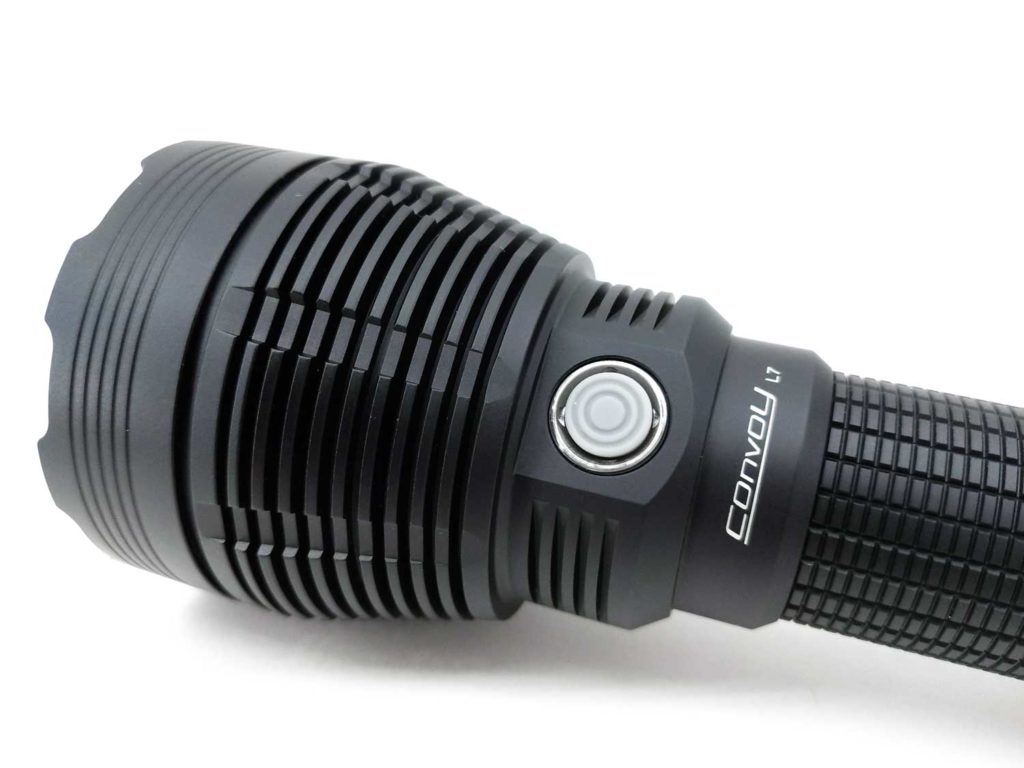
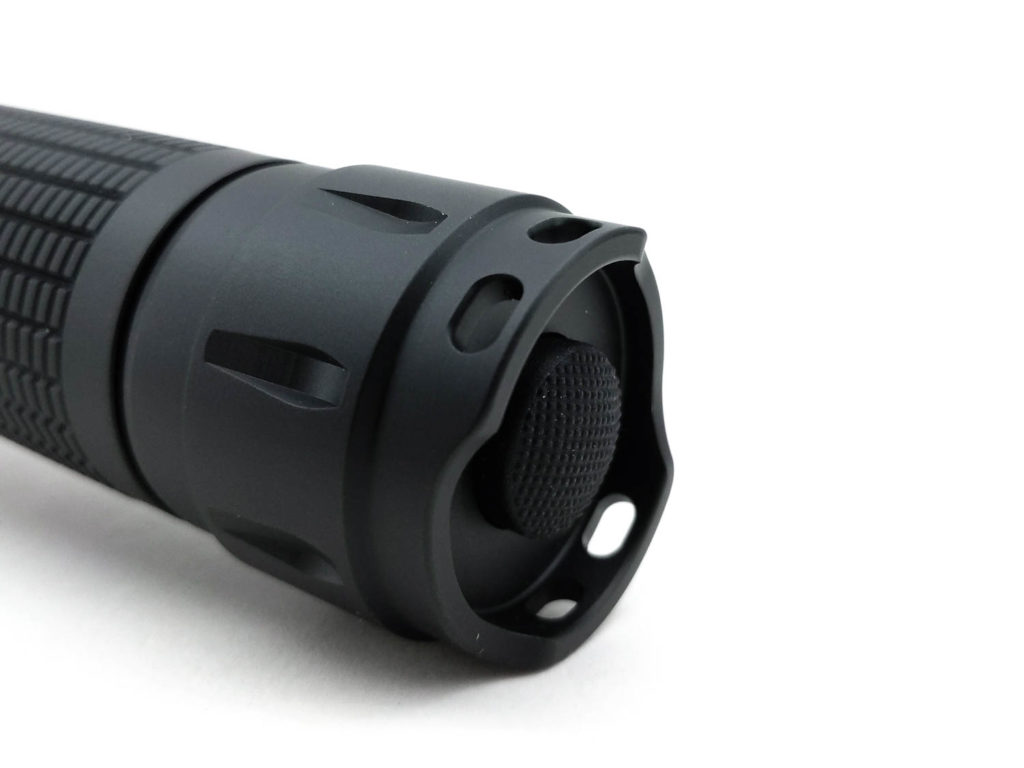
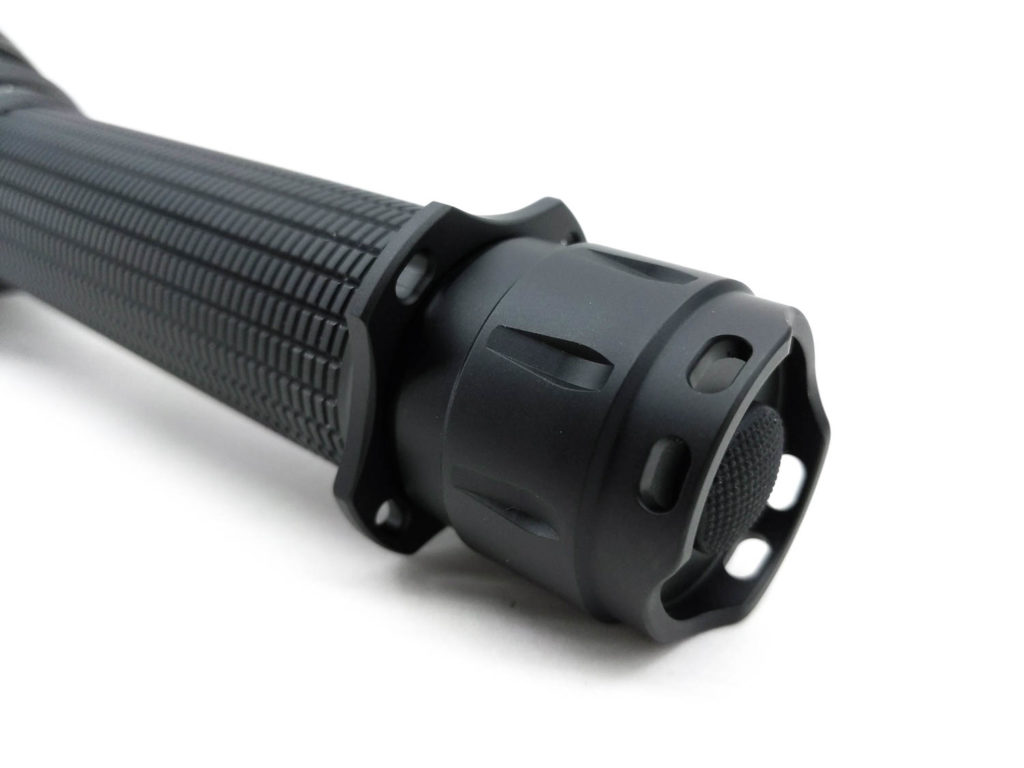
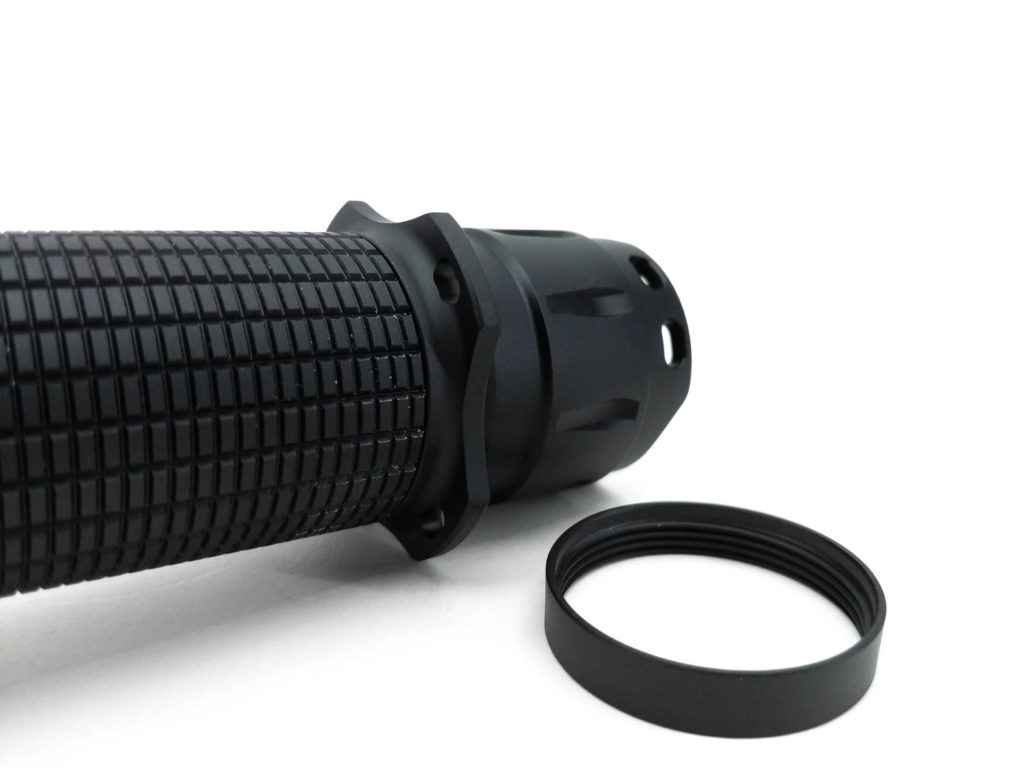
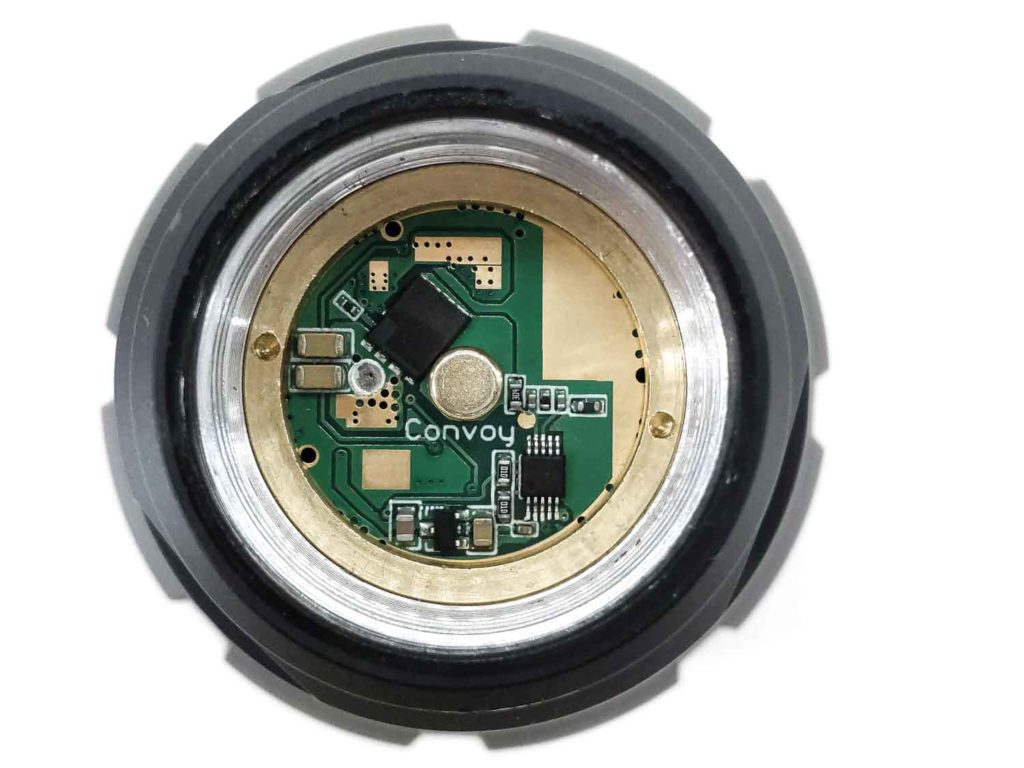
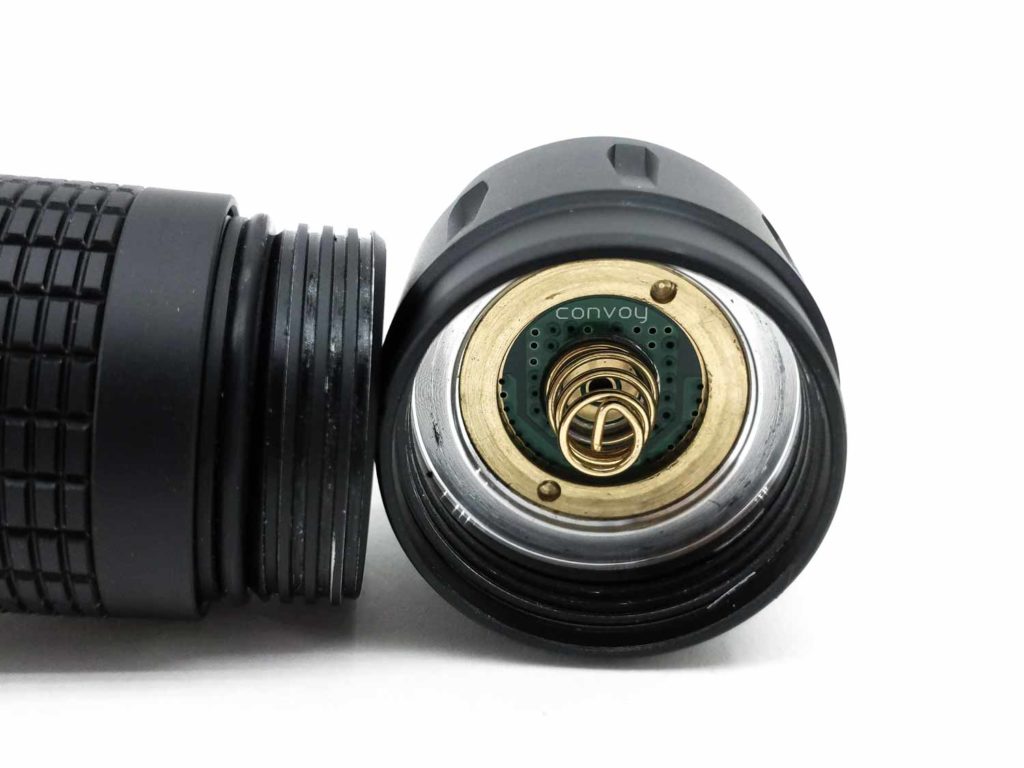
LED, Lens, Bezel, and Reflector
The star of the show here is the Luminus SBT90.2, a crazy domeless high-power emitter. It’s the most powerful 3-volt emitter that I’m aware of, capable of more than 20 amps. While it is supposedly offered in both 5700K and 6500K, I’ve only ever seen the 5700K, of which this is one. Oh, and it’s 70-CRI (the only CRI option for the SBT90.2).
The powerful LED is well centered in a large, smooth reflector. Between the emitter being domeless, high power, and the large reflector, the Convoy L7 throws really well. The bezel is crenulated, and no glue is present. So it’s easy to remove the bezel and reflector to access the LED if you’re inclined to do so.
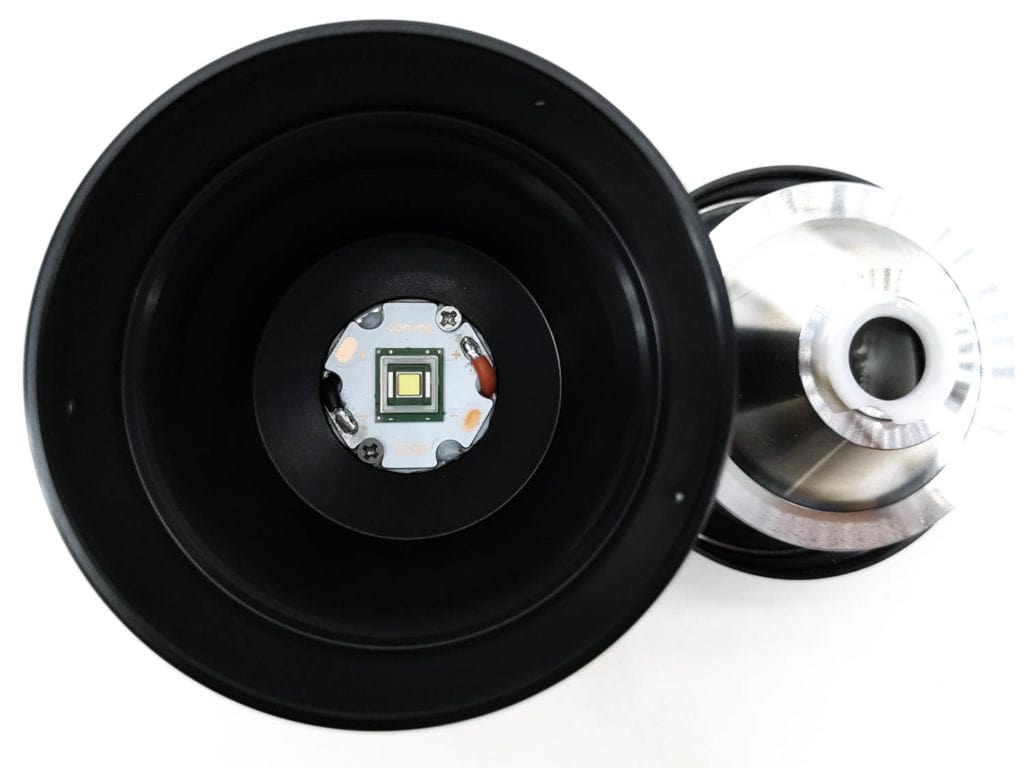
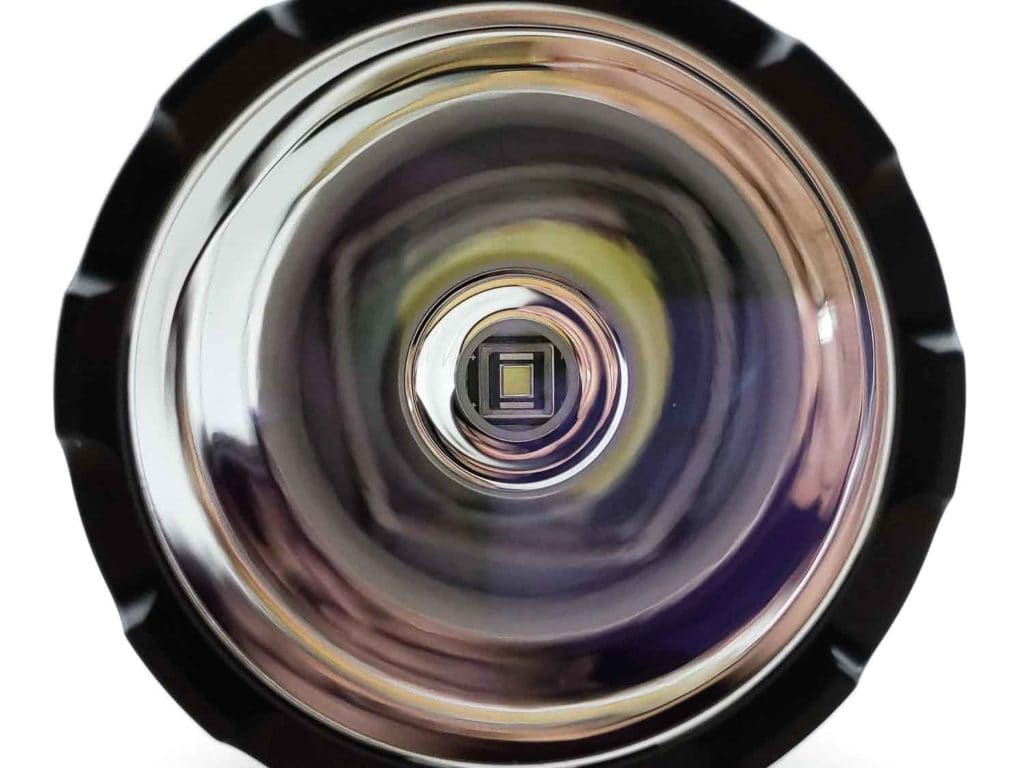
Dimensions and flashlight size comparison
- Length: 251 mm / 9.9 inches
- Head diameter: 72.7 mm / 2.9 inches
- Body diameter: 35.5 mm / 1.4 inches
Weight:
- Without cells: 537 grams / 18.9 oz
- With cells: 726 grams / 25.6 oz
Flashlight size comparison
New Convoys, left to right: Convoy M21D, Convoy 3x21A, Convoy L7
Convoy throwers: Convoy M21D, Convoy L7, Convoy C8+
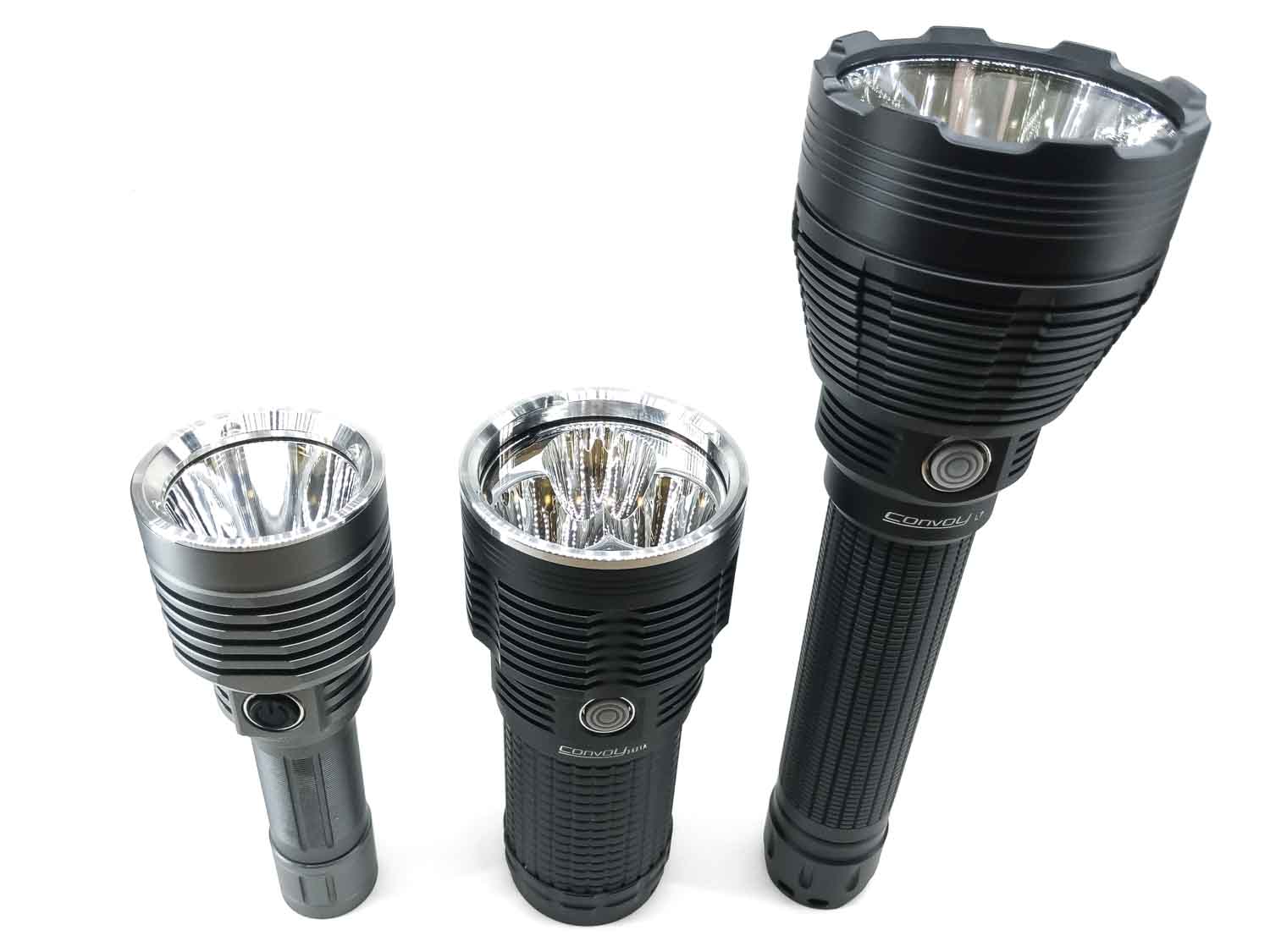
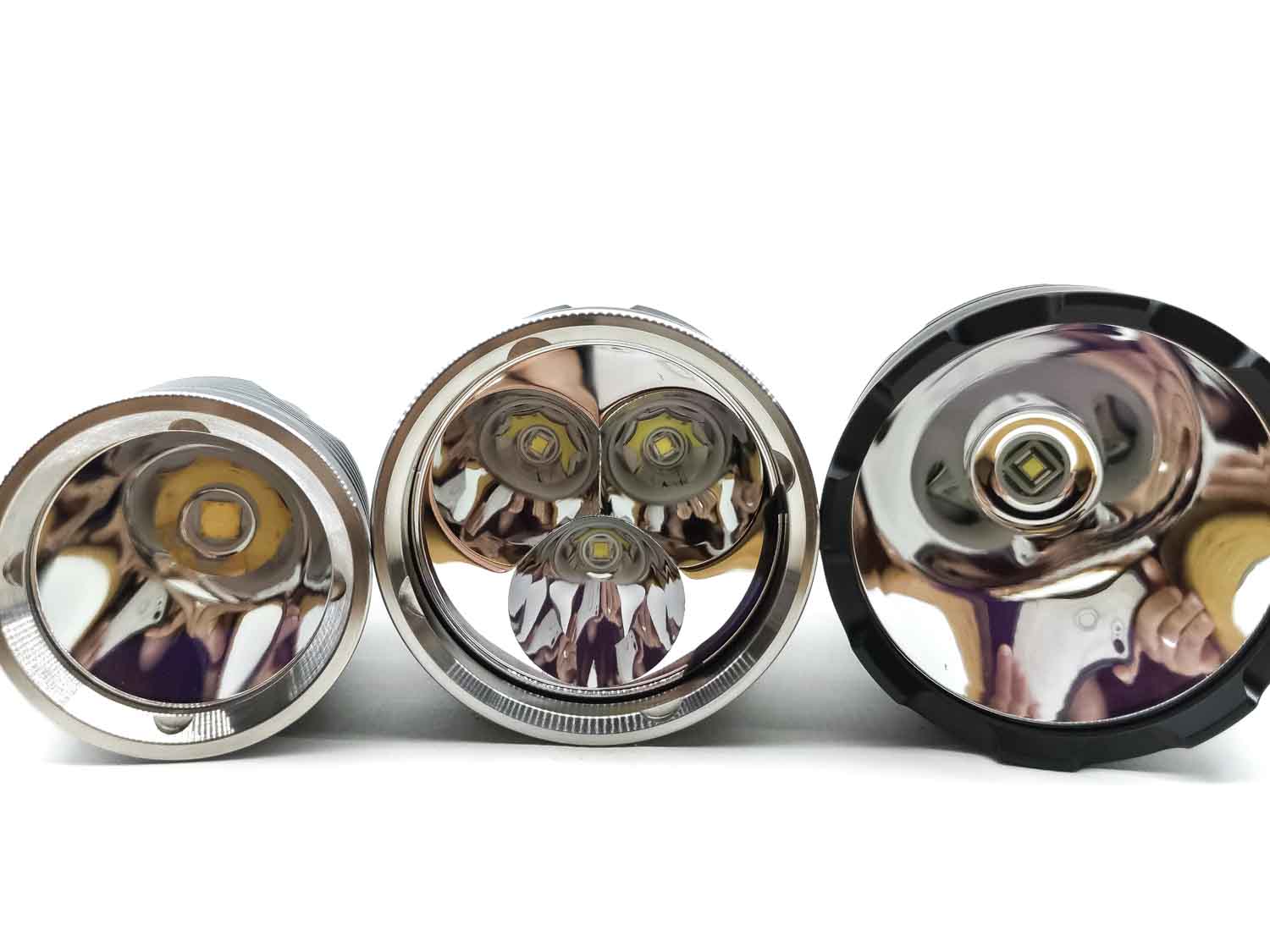
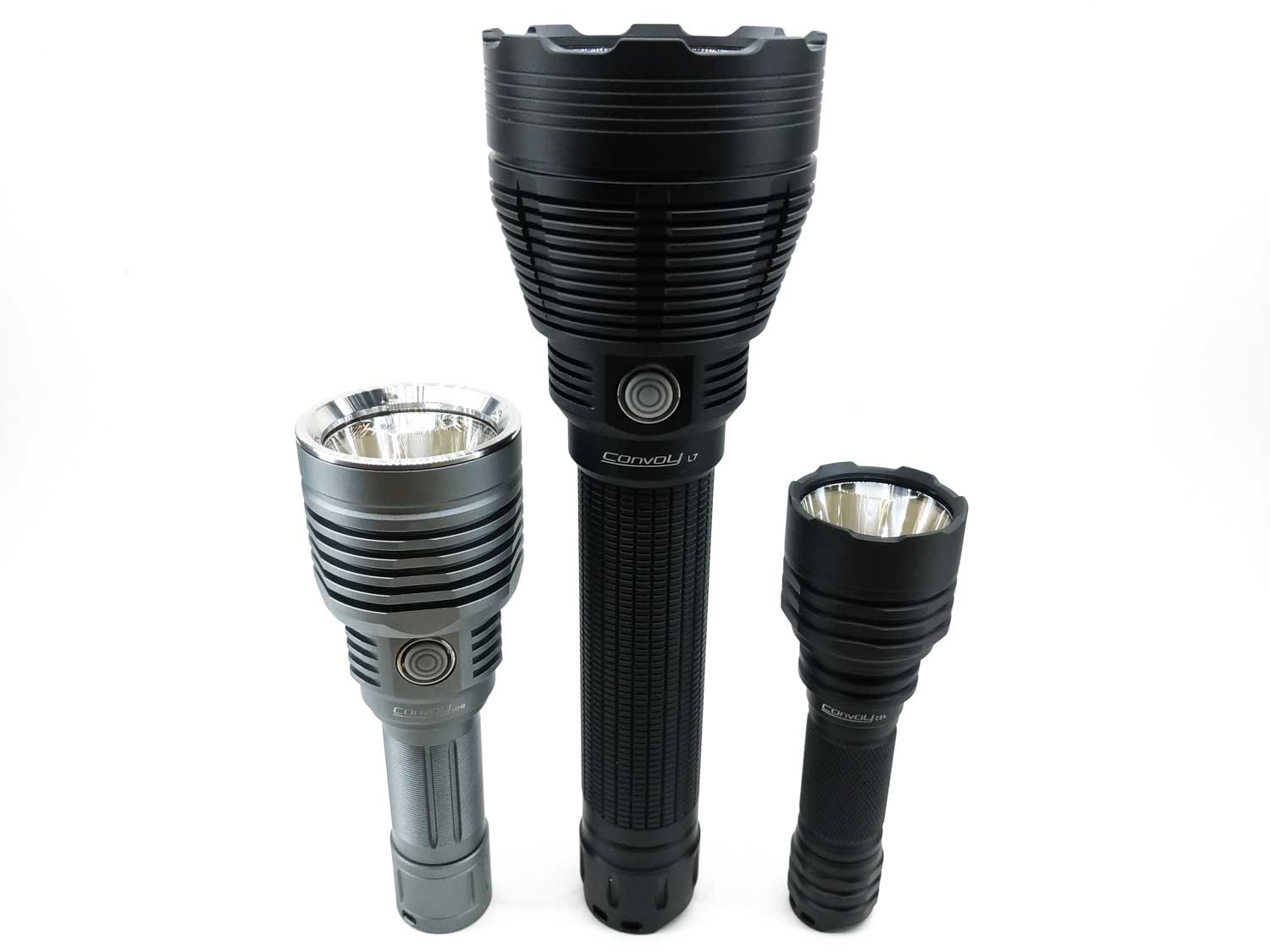
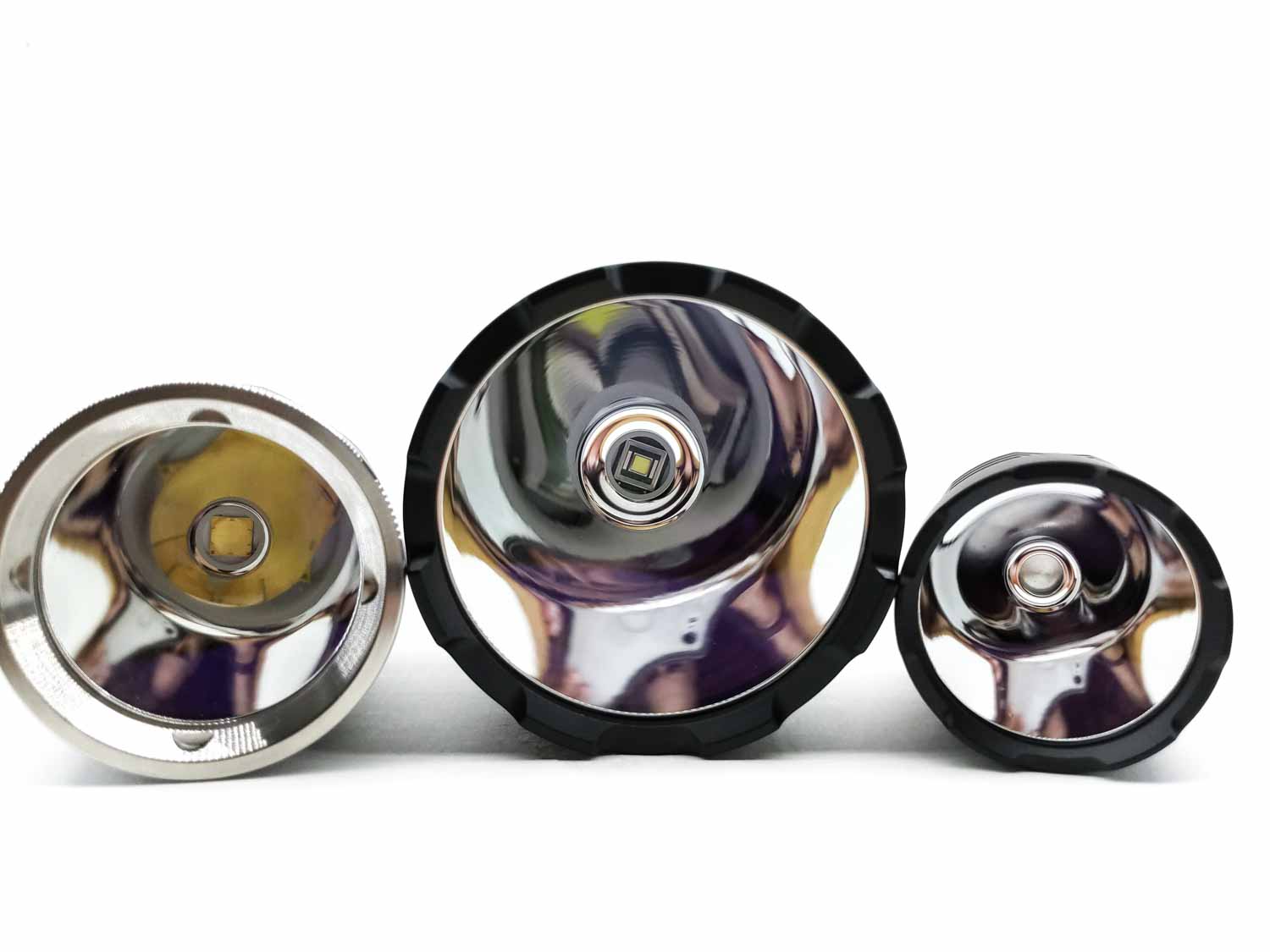
Driver & User Interface:
A flashlight’s UI is definitely a personal preference kind of thing. While many folks prefer simple user interfaces, I do like having something more advanced (like Anduril) in EDC lights. But when it comes to large lights, especially throwers, I welcome a basic UI. And that’s exactly what Simon delivered in the Convoy L7. The two switches make the L7 dead simple to operate: the rear switch turns the light on and off. The front switch changes modes. That’s all there is to it!
Available modes: Low (1%), Medium (10%), High (35%), Turbo (100%)
From OFF:
- Press and Hold, rear switch: momentary on, last used mode
- Single click, rear switch: turn on, last used mode
From ON:
- Single click, rear switch: turn off
- Single click, front switch: change mode (L>M>H>T)
- Double click, front switch: strobe mode
Mode memory:
- Yes, there is mode memory
Shortcuts:
- None
Low voltage warning:
- The light blinked 3 times before dropping down to 79 lumens
Strobe/blinkies
- There is one Strobe mode
Lock-out mode:
- No electronic lock-out, but you may consider the rear switch as a lock-out
- You may also untwist the tailcap to serve as a lock-out
PWM
- No PWM was detected using my photodiode & the Hz feature of my DMM, which makes sense since this is a buck driver
Additional info on the UI:
- Convoy mentions that there is temperature regulation set at 55°C. There is some evidence of this being true, but it’s certainly not a very sophisticated regulation.
Batteries & Charging
The Convoy L7 requires 2x 26650 batteries. Simon says that the batteries should be able to sustain 11 amps of output, and since they’re in series, they should be button top. You could possibly get away with flat-top batteries using a magnet between cells or by “solder blobbing” the tops. The Convoy L6 was a bit picky with batteries: they couldn’t be too wide, and they couldn’t be too long. There were a few goldilocks “just right” cells that were recommended (usually protected Keeppower batteries). The Convoy L7 appears to have its own pickiness when it comes to batteries.
- I had a pair of PLB 55A flat-top cells sitting around, which is what is under the wraps of most good 5500 mAh 26650 cells. Unfortunately, even with a solder blob there was going to be no way of making those work: they were just too short.
- I also checked a pair of Molicel P42A 21700 cells that measured exactly 70.0 mm long; those actually fit though a bit snug length-wise. If going that route, you’d want to acquire a set of 21700-26650 adapters to hold them in place around the width.
- I had a new set of Keeppower model UH2652 5200 mAh 26650’s available; I’ve measured them at 66.9 x 26.3 mm. Even these are a bit short. They worked, but as soon as I tilted the flashlight up in the air, the batteries compressed the rear spring and lost connection.
- To experiment more with the length, I added a single 15.0 x 4.6 mm neodymium magnet between the cells for some extra length and they fit perfectly, no more lost connection and very little rattling.
- In summary, I think cell length of around 69.0 is about perfect for the L7 if you can find them.
You’ll notice that I didn’t mention anything about trying protected cells. For one, I don’t have any protected 26650 sitting around. And secondly, Simon said that the batteries need to be capable of 11 amps. The highest-output protected 26650’s I found were Keeppowers, and those were “only” rated at 10 amps continuous. They might work, but I can’t say for sure.
Simon does have the L7 listed with the option of buying batteries with it. He provides a choice of Liitokala Lii50A 26650 5000mAh or Keeppower 26650 5500mAh. The Liitokala are listed as having a length of 68mm which is probably pretty good, but Simon has them rated at 5 amps max continuous discharge (not sure if that’s accurate). The Keeppower offering has a higher discharge rate (20 amps), but I’m curious if they’re long enough to fit well.
In the end, I ended up using the Keeppower 5200 mAh batteries for testing, no magnet. I just made sure not to tilt the flashlight upwards. If you’d like to do some more reading about battery sizes, I posted a question over at BudgetLightForum to see what batteries other folks were using: link.
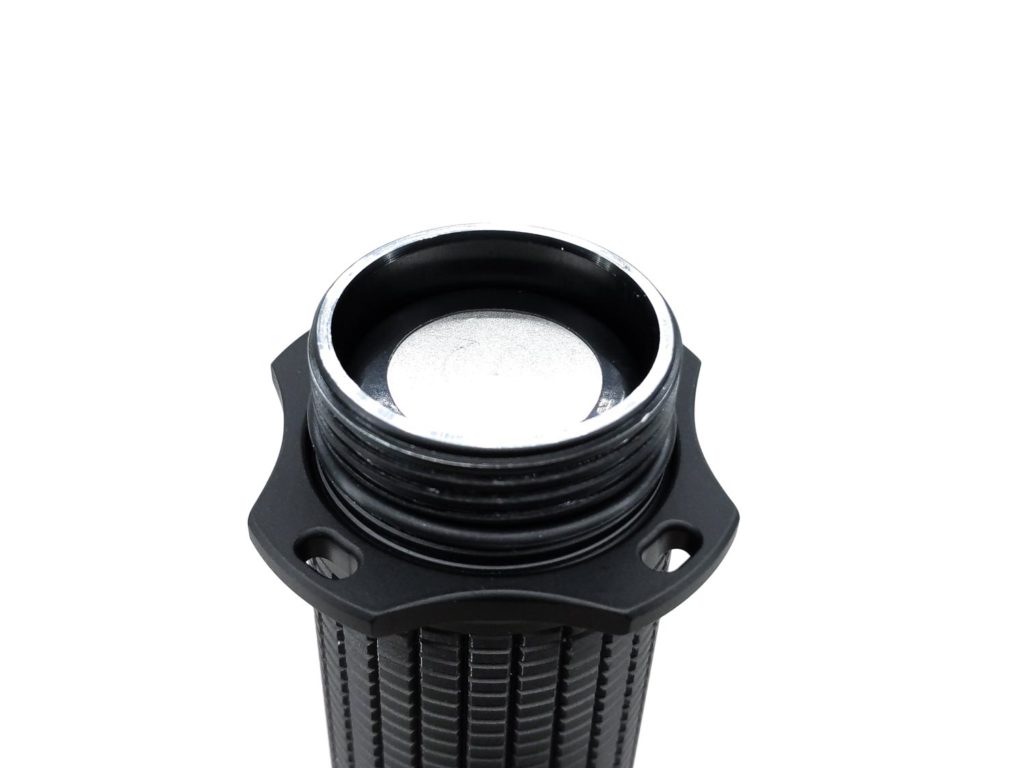
Performance
For current measurements, an ANENG AN8008 multimeter and UNI-T UT210E clamp meter were used. Lux was measured by a UNI-T UT383 BT at 10 meters. Lumens were measured in a homemade lumen tube using a TSL2591 sensor, calibrated with a Maukka calibration light. Testing was performed with two Keeppower 5200 mAh 26650 batteries.
Lumen measurements (for each mode)
| Mode | Amps at start | Specs | 10min | 30 sec | start |
|---|---|---|---|---|---|
| Low | 142 mA | – | – | – | 80 |
| Med | 750 mA | – | – | – | 749 |
| High | 3.1 A | – | 2421 | 2496 | 2528 |
| Turbo | 9.1 A | 5900 lm* | 3341 (cooled), 2585 (no fan) | 4657 lm | 4853 lm |
* Convoy’s lumen spec states “maximum 5900LM, theoretical LED output value, the actual light output is lossy, for reference only.” So that’s to be taken with a grain of salt, it seems a bit high for a single SBT90.2.
Parasitic drain:
- N/A (tail switch)
Runtime graph
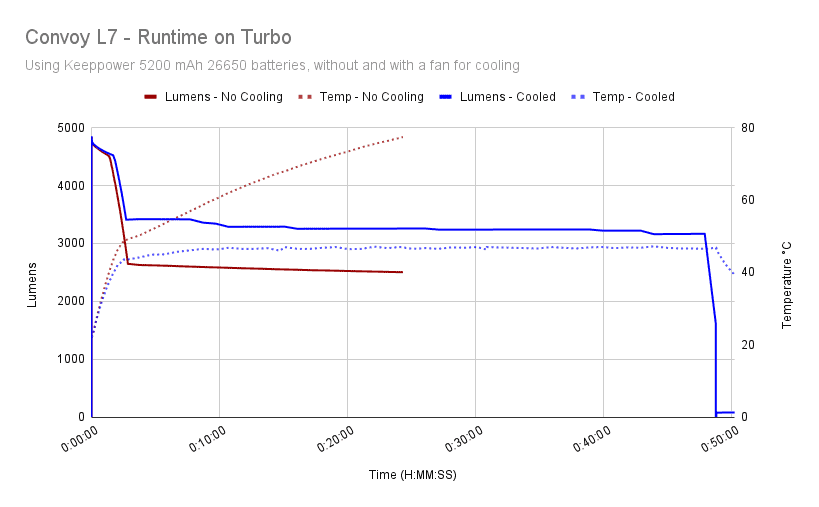
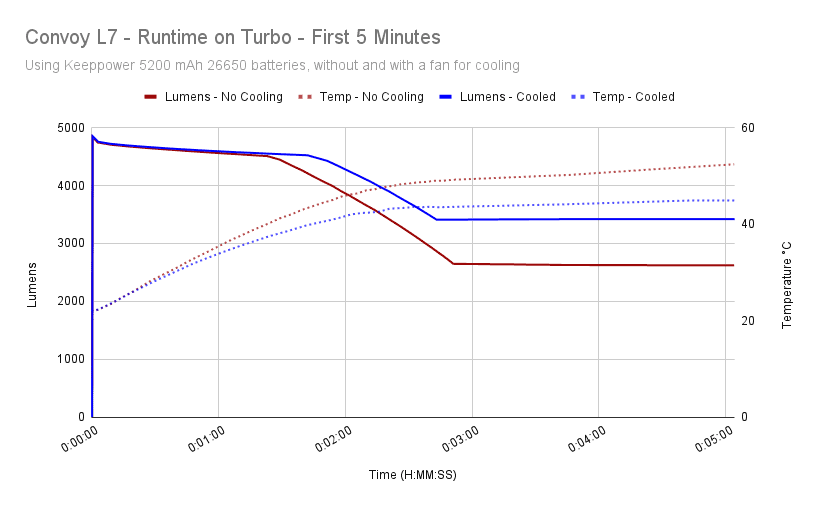
The first test I conducted was a Turbo runtime test. It started out at 4841 lumens and dropped slowly until it hit the 1m24s mark, when it began a steady ramp-down to 2648 lumens. The L7 stayed right around there and the temperatures began creeping higher and higher. By 24 minutes, the light hit 77°C and I aborted the test for safety purposes (and the health of the batteries).
I recharged the batteries again and performed another Turbo test, but this time I aimed a small fan at the L7. Output started at 4853 lumens, and again slowly dropped until it began a more rapid descent at 1m42s. This time the output didn’t ramp down as far, it halted at 3410 lumens. Output stayed close to that until the low voltage warning (3 blinks) happened at 48 minutes. The light chugged along at 79 lumens until it finally shut off at 3 hours and 53 minutes (more than 3 hours after the warning!). The behavior of this test tells me there is some kind of thermal regulation going on, as Convoy claims. With cooling, the light didn’t ramp down as much or as fast. But that first test seems to indicate that the 2648 lumens may have been a predefined floor that thermal regulation wouldn’t go below since its temperature continued to climb into worrisome territory.
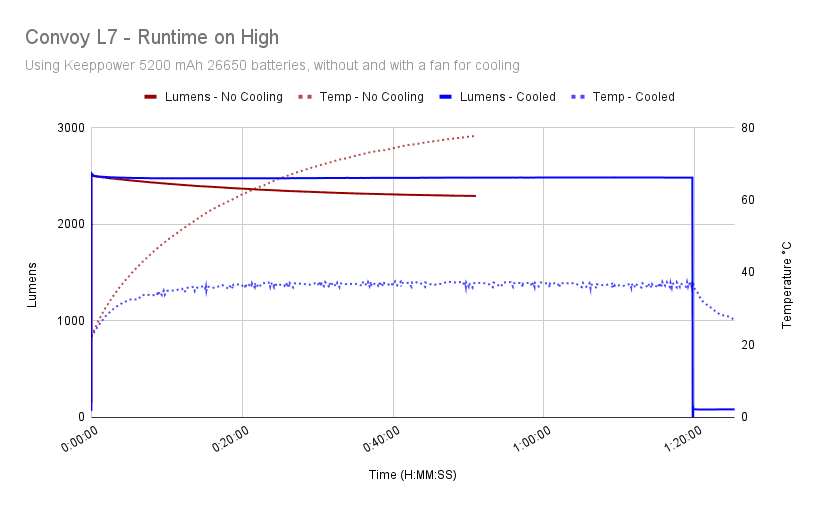
I then proceeded to do a High runtime test. With the exception of the Turbo period, it performed much the same. It began at 2520 lumens and held steady. But after 51 minutes, the temperature rose to 78 degrees and I aborted the mission. I re-ran the test with the fan output stayed steady until 1 hour and 20 minutes when the low voltage warning happened. And again, the L7 continued on at 80 lumens until 4 hours and 12 minutes.
Throw numbers:
For the throw measurements, I tested the L7 at 10 meters using my UNI-T UT383 BT and a calibration factor based on the Maukka calibration light.
| Mode | Specs | Candela measured | Meters | Yards |
|---|---|---|---|---|
| Low | – | 7,000 cd | 167 | 183 |
| Medium | – | 67,100 cd | 518 | 566 |
| High | – | 233,000 cd | 965 | 1055 |
| Turbo | 435,000 cd | 417,000 cd | 1291 m | 1412 |
Beamshots
The farm shed in these beamshots is 100 meters (109 yards) away. Pictures were taken with my Pixel 3 using ƒ/1.8, ⅕ second exposure time, ISO200, and 5000K white balance.
- Convoy L7
- Convoy 3x21A
- Convoy M21D
- Mateminco MT90Mini SBT90.2
- Fenix LR50R
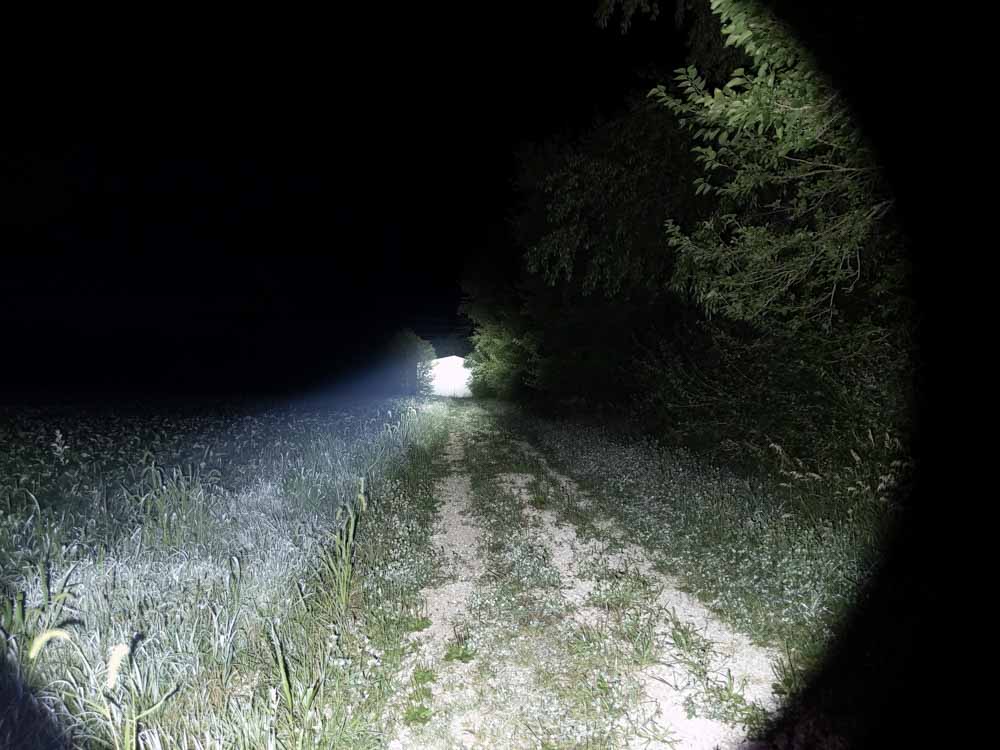



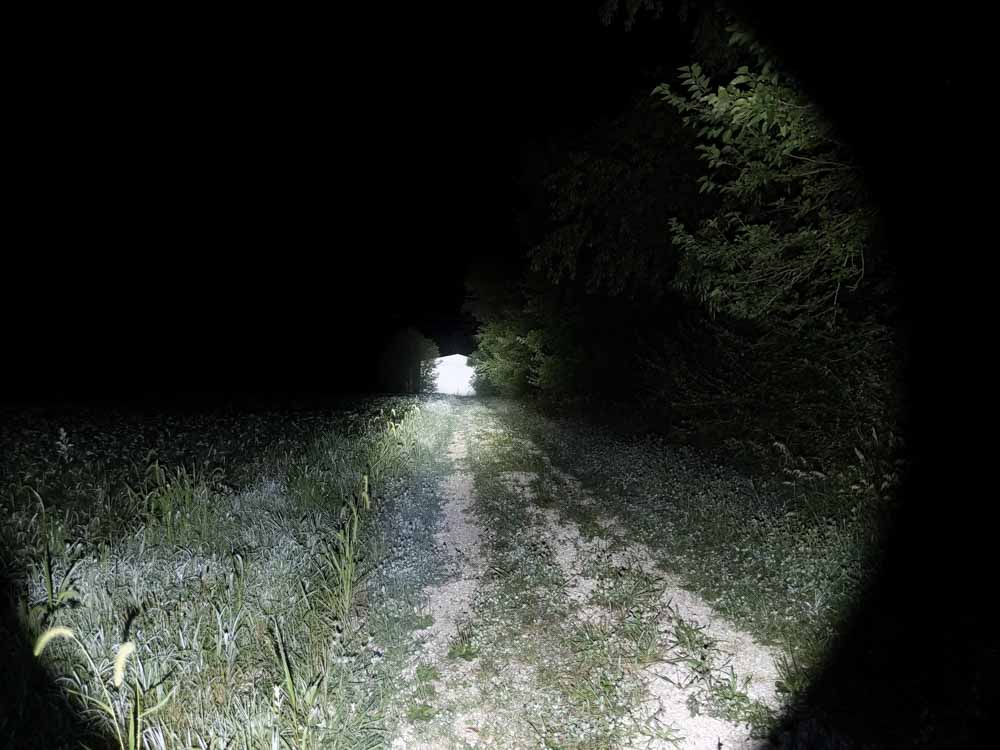
Disclaimer: This flashlight was sent to me for review at no cost by Convoy. I have not been paid to review, nor have I been holding back on problems or defects.
Final Verdict
Pros
- Bright and throwy
- Sturdy build
- Simple UI
Cons
- Questionable temperature regulation
- Picky about batteries
Explanation on star ratings:
1: Avoid: my phone flashlight would be a better choice – 2: Poor: significant defect or issues, much better options available at the same price – 3: Average: some defects or issues – 4: Good: recommended (minor issues) – 5: Great: highly recommended

4.5 stars: ★★★★⋆
At times during this review, I wish I had an L6 sitting around to compare against the new Convoy L7. The problem is, anytime I have an L6 on hand it always finds itself going home with someone that’s been awe-inspired by its build and impressive output. I’m glad to say that the L7 brings everything I’ve liked about the L6, and then cranks it up a notch. Unlike the L6 with its Cree-rainbow-inducing XHP70.2, the Convoy L7 ships with the high-output and super-throwy Luminus SBT90.2 which I am glad to say has a nice smooth beam without any major tint-shift.
While it’s welcome to see some semblance of thermal regulation, it needs a bit of work. Even after dropping down the first time, the L7 can still get crazy hot. Oh, and the battery fitment is a bit particular. I’m sure the flashlight community will figure out what batteries work best with the L7 before too long. You can always use a good neodymium magnet though and just not worry about it.
The new updates like the Luminus SBT90.2 and additional cooling fins make the Convoy L7 a worthwhile upgrade over the trusty L6.
Convoy L7 for sale
1lumen selects and reviews products personally. We may earn affiliate commissions through our links, which help support our testing.